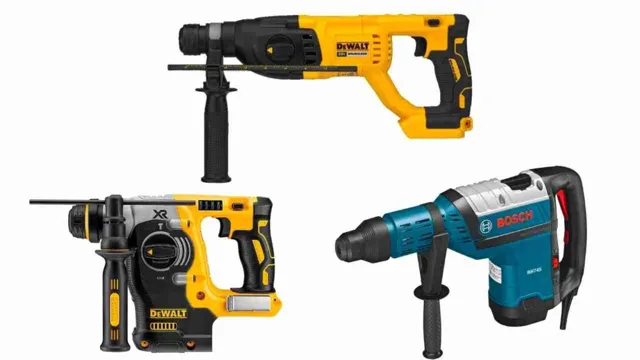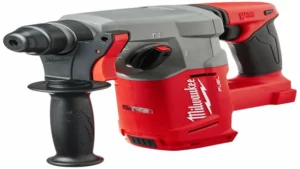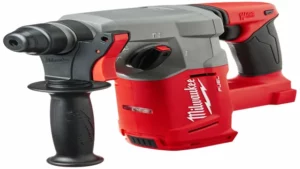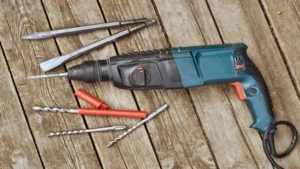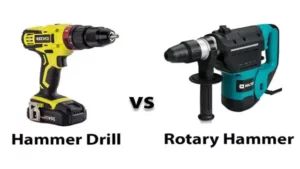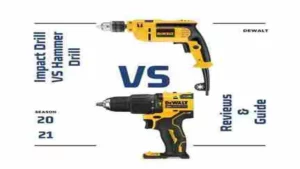If you’re looking to tackle heavy-duty drilling tasks, then the rotary hammer drill is the tool for you. This powerful tool can handle a variety of drilling jobs, from breaking through concrete to drilling into tough materials like stone and masonry. However, mastering the rotary hammer drill requires more than just knowing how to turn it on and off.
In this comprehensive guide, we’ll take you through all the basics of using a rotary hammer drill. From understanding the different types of drills available and their features, to knowing the proper techniques for handling the tool safely and efficiently, you’ll be equipped with all the information you need to become a pro at using this powerful tool. We’ll cover everything from choosing the right rotary hammer drill for your needs, to selecting the right bits and accessories for the job, and offer tips on how to avoid common mistakes that can damage the drill or the material you’re working on.
Plus, we’ll provide you with step-by-step instructions on how to use the rotary hammer drill for a range of tasks, including drilling holes, removing tiles, and breaking up concrete. Whether you’re a DIY enthusiast or a professional tradesperson, this guide will be your go-to resource for mastering the rotary hammer drill and taking on even the toughest drilling jobs with ease. So, buckle up and get ready to unleash the full power of this versatile tool!
Introduction to Rotary Hammer Drills
If you’re new to DIY projects or home repairs, using a rotary hammer drill may seem intimidating, but with a little practice, it can become a valuable tool in your toolbox. First, make sure to select the right size and type of drill bit for the job. Rotary hammer drills can handle tough materials like concrete and brick, but they require specific bits to do so effectively.
Next, adjust the depth gauge to ensure you don’t accidentally drill too deep. Always wear proper safety gear, including eye protection and gloves. When drilling, apply firm, steady pressure and let the drill do the work.
Avoid putting too much pressure on the drill, which can cause the bit to break or damage your workpiece. With a little practice and patience, you’ll master the art of using a rotary hammer drill in no time.
Understanding the Purpose of a Rotary Hammer Drill
A rotary hammer drill is an essential tool for any construction or renovation project. It is a powerful drilling machine that delivers rapid, efficient, and precise drilling through hard materials such as concrete, stone, or masonry. Unlike regular drills, rotary hammer drills use a hammering motion, which enables them to penetrate solid surfaces.
Rotary hammer drills are typically heavier, larger, and more powerful than standard drills, which allows them to withstand tough materials. The drills also come with different settings, such as hammer and drill mode or hammer-only mode, giving them versatility for various applications. If you are looking to work on a concrete slab floor or a brick wall, a rotary hammer drill will make the task quicker and more efficient.
Its capability to drill larger holes, quickly and effortlessly, helps save time and energy. Whether for professional or DIY use, having a rotary hammer drill is crucial to achieving the best possible results in projects that involve hard materials.
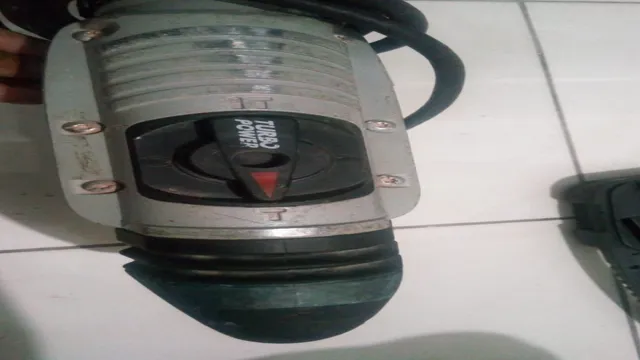
Different Types of Rotary Hammer Drills Available
Rotary Hammer Drills Rotary Hammer Drills are an essential tool for any professional or DIY enthusiast who needs to tackle heavy-duty drilling or chiseling tasks. These drills are designed to deliver a powerful forward thrust and intense rotary force that can quickly break through tough materials like brick, concrete, and stone. There are various types of rotary hammer drills available to meet different drilling needs.
The most common ones include SDS-plus, SDS-max, and spline rotary hammer drills. SDS-plus rotary hammer drills are ideal for medium-duty tasks such as drilling small holes in concrete or masonry, while SDS-max drills are perfect for heavy-duty drilling and demolition work. Spline rotary hammers provide a smooth, consistent drilling experience, making them best suited for less demanding tasks like drilling through wood and metal.
Regardless of the type, rotary hammer drills are powerful, versatile tools that can help you get the job done quickly and efficiently.
How to Use a Rotary Hammer Drill
If you’re planning to do some DIY home improvements, a rotary hammer drill can be a helpful tool to have on hand. Before using it, make sure to read the manufacturer’s instructions carefully so you know how to operate it safely. The first step is to insert the appropriate drill bit, making sure it’s secure before starting.
Next, adjust the depth gauge to ensure you’re drilling to the correct depth. When you’re ready to start drilling, hold the drill firmly with both hands and choose the appropriate speed for the job. Remember to apply steady pressure and let the drill do the work, avoiding pushing too hard or forcing it.
If you need to drill into hard surfaces such as brick or concrete, make sure to use the hammer function by switching the mode selector switch to “hammer”. With the right technique, a rotary hammer drill can make your DIY projects much more manageable and efficient.
Safety Precautions to Take When Using a Rotary Hammer Drill
If you’ve never used a rotary hammer drill before, it may seem intimidating at first. But with a little practice and some safety precautions, you’ll be able to tackle even the toughest projects. First and foremost, it’s important to read the manual before operating the tool.
This will give you a good understanding of the drill’s capabilities and safety features. It’s also a good idea to wear protective gear, including safety glasses, earplugs, and a dust mask. When using the drill, keep both hands on the tool and maintain a firm grip to prevent it from slipping or getting away from you.
Additionally, be mindful of the drill’s cord, making sure it’s out of the way and not a tripping hazard. Finally, be aware of your surroundings and never force the drill if it’s not working properly. Overall, a rotary hammer drill can be a valuable tool for construction and DIY projects, as long as you follow these safety precautions.
Preparing for the Job: Choosing the Right Drill Bit and Setting Up the Work Area
When it comes to using a rotary hammer drill, preparation is key. Before you even start drilling, you need to choose the right drill bit for the job. Consider what type of material you’ll be drilling into and choose a bit that’s specifically designed for that material.
Once you’ve chosen the right bit, it’s time to set up your work area. Make sure you have plenty of space to work in and clear away any debris or clutter. It’s also a good idea to wear protective gear, such as safety glasses and a dust mask, to keep yourself safe while drilling.
When you’re ready to start drilling, hold the drill at a slight angle and make sure the bit is centered on the marked spot. Engage the machine and start drilling slowly and steadily, using firm pressure. As you drill, keep the machine straight and don’t force the bit.
If you feel any resistance or the drill isn’t making progress, you may need to switch to a different bit or adjust your angle. As you work with your rotary hammer drill, keep in mind that it’s a powerful tool that requires concentration and attention to detail. But with the right preparation and technique, you can complete your drilling tasks quickly and safely.
Whether you’re working on a professional project or tackling a DIY job at home, a rotary hammer drill can be a valuable tool to have in your arsenal.
Using the Rotary Hammer Drill: Step-by-Step Guide with Illustrations
If you are looking to do some heavy-duty drilling, a rotary hammer drill is the perfect tool for the job. But how do you use one? Here’s a step-by-step guide with illustrations to help get you started. First, select the appropriate bit for your task.
Then, attach the bit to the rotary hammer drill and ensure it is secured tightly. Position the drill where you want to start drilling, and lock the drill’s trigger in the “on” position. Slowly and steadily press the drill bit into the surface, letting the tool do the work for you.
If at any point you need to adjust the angle of the bit, stop drilling, and repeat the process. When you’re finished drilling, release the trigger, remove the drill bit, and store the tool in a dry, safe place. And there you have it – a brief yet effective guide to using a rotary hammer drill.
Happy drilling!
Tips and Tricks for Efficient Drilling
If you’re looking to tackle a DIY project that requires drilling through tough materials such as concrete, brick, or stone, a rotary hammer drill is the ultimate tool for the job. When used correctly, a rotary hammer drill can make fast work of even the toughest materials, saving you time and effort in the process. Here’s how to use one effectively: First, ensure that you have the correct drill bit for the job.
Next, set the depth gauge to the desired depth of the hole. Hold the rotary hammer drill firmly with both hands, and apply pressure slowly and steadily as you begin drilling. Allow the drill bit to work through the material at a steady pace, being careful not to apply too much pressure or the bit may become stuck.
Once you’ve drilled to your desired depth, slowly release the pressure on the drill and wait for it to stop before removing it from the hole. With the right technique, a rotary hammer drill can make drilling through tough materials a breeze.
Troubleshooting Rotary Hammer Drill Problems
If you’re having issues with your rotary hammer drill, don’t worry – you’re not alone! It’s important to know how to use a rotary hammer drill properly to avoid problems, but even with proper use, issues can arise. One potential problem is if the drill bit stops rotating. Before panicking, you should check the chuck to make sure it’s properly secured around the bit.
Another issue you may encounter is the drill making a strange noise or vibrating excessively. This could indicate that the tool needs to be lubricated or that the brushes need to be replaced. If you have trouble with the drill bit jamming or getting stuck in the material you’re drilling into, it could be because the bit is dull or damaged.
Regardless of the issue, it’s important to troubleshoot the problem as soon as you notice it to prevent further damage or safety hazards. With a little bit of patience and maintenance, you can get your rotary hammer drill back to working at its best.
Possible Issues You Might Encounter When Using a Rotary Hammer Drill
Rotary Hammer Drill Troubleshooting Rotary hammer drills are powerful tools commonly used in construction and renovation projects. However, like any other tool, they can encounter problems. One common problem with rotary hammer drills is a stuck bit.
This could be due to an accumulation of debris in the chuck or the bit being bent. To fix this issue, remove the bit and clean the chuck thoroughly. If the chuck is damaged, it might be best to replace it.
Another issue is the hammer mode not working properly. This could be because of worn-out carbon brushes or a broken wire. To fix this problem, replace the carbon brushes or check the wiring connections.
Additionally, if the drill makes an unusual noise or feels weaker than usual, it might be due to a damaged gear or transmission. In this case, it would be best to have a professional take a look at it. By troubleshooting these issues, your rotary hammer drill can continue to be a reliable tool for your projects.
Remember to always take safety precautions, such as wearing protective gear, when using any power tool.
How to Solve Common Problems with Rotary Hammer Drills
Rotary Hammer Drill Problems Rotary hammer drills are popular power tools used in various projects, ranging from construction to DIY tasks. However, like any other equipment, they are prone to malfunction at times, which can lead to a significant setback in your project. One common problem that occurs with these drills is the motor not working, which can be caused by overheating or a broken wire.
To resolve this issue, you can try disconnecting the power supply, allowing the drill to cool down, and then reconnecting the power. Another problem you may encounter is the drill not producing enough power, which can be due to a dull or worn-out bit. In this case, replacing the bit is a quick fix.
Overall, understanding how to troubleshoot common rotary hammer drill problems can save you time and money while ensuring your project runs smoothly.
Final Thoughts and Recommendations
Using a rotary hammer drill can seem intimidating at first, but with some practice and proper technique, it can become a useful tool for DIY projects and professional work. Before drilling, make sure to choose the correct bit and ensure it is securely fastened to the drill. It is also important to wear appropriate safety gear, such as goggles and ear protection.
To start drilling, place the bit on the surface and apply gentle pressure to start the hole. Use a steady, back-and-forth motion to drill through the material. It’s important to not force the drill or let it overheat, which can damage both the tool and the material being drilled.
With these tips in mind, using a rotary hammer drill can be an effective way to get precise and clean holes in a variety of materials.
Conclusion
So there you have it, folks! Using a rotary hammer drill is not rocket science, but it does take a bit of finesse and knowledge. Just remember to use the right drill bit for the job, keep a steady hand, wear your safety gear, and don’t be afraid to let that hammer drill rip! With these tips in mind, you’re sure to bust through any tough project with ease. Now go forth, DIYers, and show that wall who’s boss!”
FAQs
What is a rotary hammer drill and how does it work?
A rotary hammer drill is a power tool that uses a hammering action while rotating to drill through tough surfaces like concrete or masonry. It has a piston mechanism that delivers a high impact force, allowing for efficient drilling and chiseling.
What are the different types of bits that can be used with a rotary hammer drill?
Rotary hammer drills can accommodate various types of bits, including masonry drills, chisels, spade bits, and hole saws. It’s important to choose the appropriate bit for the material you’re drilling as well as the task at hand.
What are some safety precautions to take when using a rotary hammer drill?
Always wear appropriate safety gear, including eye and ear protection, and gloves. Avoid wearing loose clothing or jewelry that could get caught in the drill. Keep the drill away from electrical sources and use a ground-fault circuit interrupter (GFCI) when working near water.
Can a rotary hammer drill be used for other tasks besides drilling?
Yes, rotary hammer drills can also be used for chiseling, demolition, and scaling. Many models come with interchangeable chisels or bits specifically designed for these tasks.
What is the maximum depth a rotary hammer drill can drill?
The maximum depth a rotary hammer drill can drill depends on the size of the bit, the power of the drill, and the density of the material being drilled. In general, most rotary hammer drills can drill up to several inches in depth.
How do I choose the right rotary hammer drill for my needs?
Consider the size of the projects you’ll be working on and the materials you’ll be drilling through. Look for a drill with sufficient power, speed, and capacity, as well as features like adjustable depth stops and vibration control.
How do I maintain and care for my rotary hammer drill?
Clean the drill after each use and inspect it for any damage or wear. Replace any worn or damaged parts promptly, and keep the drill well-lubricated. Store the drill in a dry, cool place away from moisture and direct sunlight.
